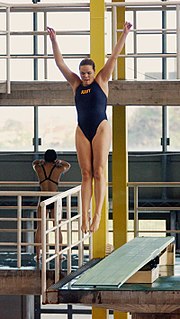Diving refers to the sport of performing acrobatics whilst jumping or falling into water from a platform or springboard of a certain height. Diving is an internationally-recognized sport that is part of the Olympic Games. In addition, unstructured and non-competitive diving is a common recreational pastime in places where swimming is popular.
While not a particularly popular participant sport, diving is one of the more popular Olympic sports with spectators. Successful competitors possess many of the same characteristics as gymnasts and dancers, including strength, flexibility, kinaesthetic judgment and air awareness.

In the recent past, the success and prominence of Greg Louganis led to American strength internationally. More recently, the greatest diving nation has been China, which came to prominence several decades ago when the sport was revolutionized by national coach Liang Boxi and after intense study of the dominant Louganis. China has lost few world titles since. Other powers are generally those which import Chinese coaches, including Australia and Canada.
Competitive diving
Most diving competitions consist of three disciplines: 1m and 3m springboards, and the platform. Competitive athletes are divided by gender, and often by age groups as well. In platform events, competitors are allowed to perform their dives on either the five, seven and a half (generally just called seven) or ten meter towers. In major diving meets, including the Olympic Games and the World Championships, platform diving is from the 10 meter height.
Divers must perform a set number of dives according to various established requirements, including somersaults and twists in various directions and from different starting positions. Divers are judged on whether and how well they completed all aspects of the dive, the conformance of their body to the requirements of the nominated dive, and the amount of splash created by their entry to the water. Theoretically, a score out of ten is supposed to be broken down into three points for the takeoff, three for the flight, and three for the entry, with one more available to give the judges flexibility.
The raw score is multiplied by a difficulty factor, derived from the number and combination of movements attempted. The diver with the highest total score after a sequence of dives is declared the winner.
Synchronized diving
Synchronized diving was adopted as an Olympic sport in 2000. In this event, two divers form a team and attempt to perform dives simultaneously. The dives are usually identical; however, sometimes the dives may be opposites, in what is called a pinwheel. In these events, synchronicity is valued as highly as technical skill.




No comments:
Post a Comment